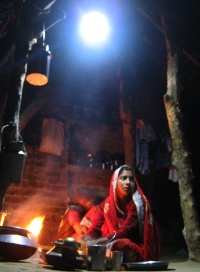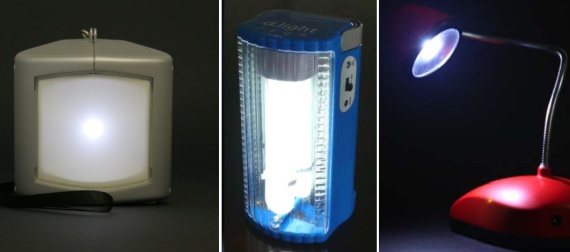 A San Francisco-based company with plans to help the developing world snuff out its kerosene-burning lamps and replace them with cheap, solar-powered LEDs and compact fluorescents has finally unveiled its production models and announced the details of its for-profit business plan.
A San Francisco-based company with plans to help the developing world snuff out its kerosene-burning lamps and replace them with cheap, solar-powered LEDs and compact fluorescents has finally unveiled its production models and announced the details of its for-profit business plan.
We’ve followed the progress of D.light Design from a Stanford design competition in late 2006 through its launch in the non-academic world, to the present moment. Started by two Stanford MBAs, D.light has been working on light designs cheap enough to be affordable for families making as little as a dollar a day, but with a big enough market to create a sizable company.
The problems with kerosene are numerous: It’s polluting and harmful to the health of those who regularly use it for light, it can start fires that injure or kill people, and surprisingly, it’s also relatively expensive — according to co-founder Ned Tozun, kerosene is a $38 billion market that can suck up to 30 percent of the income of families that have to use it regularly.
Unfortunately, that’s quite a lot of people, in part because areas that are ostensibly powered by electricity actually only get a few hours a day of current. D.light, along with similar companies like Mightylight, uses the figure of 1.6 billion people, although its initial target market in India includes “only” 72 million families.
D.light is unveiling three light designs. The one they brought to show me (far left, below) is most faithful to their original design: A nearly unbreakable plastic casing enclosing a bright, ultra-efficient LED, with a connection for a single-watt solar panel that can charge it throughout the day. The light has several settings, allowing it to last between 12 and 500 hours on a single charge. There are two other designs: A CFL-based light that charges if there’s electricity available, and a small lamp that also has a solar panel. The various parts, including the sealed lead-acid battery, are all replaceable with standard parts.
The basic idea D.light has is almost identical to Mightylight. Because of target consumer group, though, price, rather than innovation, is the most important point. D.light’s units range from $12 to $25 for an individual buyer, far below Mightylight’s $45 lights. (Another company, Selco India, is also making solar powered lights, as well as various overseas startups.)
However, Tozun said D.light still might not be cheap enough for some. “We’re cognizant of the fact that there are some families that just can’t afford the lights, no matter how low you price them,” he told me, suggesting that there’s potential for a micro-finance model to help the extremely impoverished gain access to light. There are also non-profits helping to buy the lights.
But for the families that can afford the D.light’s products, Tozun says there’s no shortage of demand. He told me that two people sent to India to scope out the target market were nearly mobbed by villagers who had been tipped off to their arrival — only to find out that they had brought none of the lights with them to sell.
Now, about that “for profit” part. It’s easy to be skeptical that D.light can make money, even on its bare-bones design — even with the founders moving to China and India to help with manufacturing and distribution. Tozun says they’ll make money, but didn’t want to discuss specifics. However, a little basic math isn’t too difficult. If D.light manages to sell 10 million units for an average of $18, using a conservative, ultra-slim 2 percent profit margin, it will have made $3.6 million. For the company’s target market of over a billion people, just multiply by a hundred; and, as with every startup, there will be opportunities to diversify.
Tozun says there’s plenty of room for other entrepreneurs, provided they’re able to understand the particularities of developing markets. He pointed out income generation, or “anything that can help these people make money,” as well as mobile phones and communications as especially hot areas.
D.light’s founders are headed out in the next week or two, and the company will be based out of China and New Delhi, India. Its investors include Draper Fisher Jurvetson, Garage Technology Ventures, Indian firms Mahindra & Mahindra and Nexus India Capital, social investment firms Acumen Fund and Gray Matters Capital, and Michael Marks, the chairman of Flextronics, but the company has not disclosed how much money it has taken.


